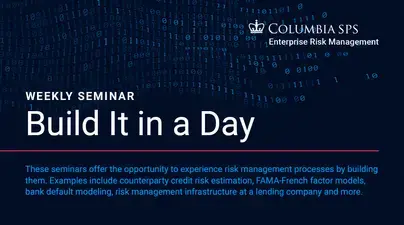Build It in a Day Seminar, Presented by the ERM Program

September 26 – October 10, 2025
Time for all workshops: 1:00 pm – 4:00 pm ET
These workshops offer the opportunity to experience risk management processes by building them. Examples include counterparty credit risk estimation, FAMA-French factor models, bank default modeling, risk management infrastructure at a lending company, the Fundamental Review of the Trading Book (FRTB), Comprehensive Capital Assessment and Review (CCAR). These major concepts are as much about their implementation as they are about their theoretical description; and organizations gain competitive advantage by effectively implementing these concepts. As a professional, a first step to adding value to this work at an organization is knowing how to build a simple version in a day.
How To Join a Session
Click here at 1:00 pm ET on the day of your desired workshop to join virtually. Each workshop ends at 4:00 pm ET.
Workshop Info
Friday, September 26 | 1:00 pm to 4:00 pm ET
FRTB (Fundamental Review of the Trading Book) 1
Delve into the revised market risk framework. Build the standardized model to understand the impact on capital requirements and risk management practices for financial institutions.
Friday, October 3 | 1:00 pm to 4:00 pm ET
FRTB (Fundamental Review of the Trading Book) 2
Delve into the revised market risk framework. Build the Internal model to understand the impact on capital requirements and risk management practices for financial institutions.
Friday, October 10 | 1:00 pm to 4:00 pm ET
CCAR
Explore the entire process of CCAR and simulate one of the government defined scenarios for a given portfolio. The workshop also reviews different institutions and their official CCAR submissions.
Apply
We encourage you to apply as soon as possible.
Request Information
Stay in the know with updates sent straight to your inbox.